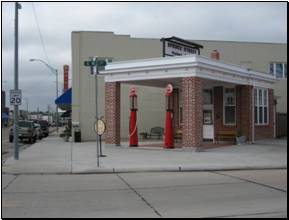Fact Sheet
January 2009
Land Revitalization, Historic Highways Project
INTRODUCTION
The U.S. Environmental Protection Agency (EPA) seeks to support the reuse and redevelopment of all types of contaminated properties. Revitalization of these properties is important because it returns land to productive use, eliminates blight, can be linked to local job development, creates recreational opportunities, energizes neighborhoods, and protects the environment.
Regardless of whether a site or property is an abandoned industrial facility, a waste disposal area, a former gas station, or a Superfund site, the land revitalization activities in Region 7 help to ensure that reuse considerations are integrated into all cleanup decisions. Contaminated and formerly contaminated sites throughout the country have been transformed into major shopping centers, business parks, residential neighborhoods, recreational facilities, and wildlife habitat. Many sites are being revitalized for use by small businesses.
As part of our mission to protect human health and the environment, EPA Region 7 is dedicated to revitalizing land by helping to restore contaminated and potentially contaminated sites to productive reuse.
HISTORIC HIGHWAYS PROJECT
The former Route 66 and Lincoln Highways are lined with crumbling abandoned gas stations. The goal of the Historic Highways Project is to bring new life to these abandoned properties by restoring them to productive reuse as playgrounds, small businesses, or other beneficial uses. EPA Region 7 is partnering with our states and other agencies on this important project to ensure that redevelopment and reuse is realized.
 An abandoned gas station along the Lincoln Highway in Jefferson, Iowa.
An abandoned gas station along the Lincoln Highway in Jefferson, Iowa.
EPA Region 7 developed an inventory of abandoned gas stations along these historic highways in Missouri, Kansas, Iowa and Nebraska during the summer of 2007, and shared the results with our state partners. The project partners helped to set the standards for prioritizing the former gas stations in the inventory, and began examining those properties that are most likely to be reused.
 A former gas station in reuse along the Lincoln Highway in Ogallala, Nebraska. This station has been listed on the National Register of Historic Places
A former gas station in reuse along the Lincoln Highway in Ogallala, Nebraska. This station has been listed on the National Register of Historic Places
ACCOMPLISHMENTS TO DATE
The Iowa Department of Natural Resources (IDNR) identified two abandoned gas stations in Carroll and Jefferson, and began working with those communities. IDNR is working with the previous owner along with a new owner to turn the former gas station in Carroll into a winery. Though the site still has contamination, IDNR will work with the previous owner to clean up the contamination while the property is being reused. The Jefferson community also seeks to revitalize their abandoned station, by turning it into a Welcome Center. The property likely needs to be assessed for contamination prior to any reuse.
The Kansas Department of Health and Environment (KDHE) prioritized six properties in Galena, Baxter Springs, and Riverton, and discussed available redevelopment resources with the Kansas Department of Commerce. The department will also consult with the mayors in those three communities about working with the project partnership team.
The Nebraska Department of Environmental Quality (NDEQ) has focused on a property in Wood River and plans to approach that community about potential reuse. The department has also talked to the Nebraska State Historical Society to determine if they have any available redevelopment funds.
The Missouri Department of Natural Resources has provided resources to conduct remedial clean-up activities at an abandoned gas station in Webb City. It is anticipated that this site will be used as a Route 66 Welcome Center.
NEXT STEPS
EPA region 7 has developed letters to send to each community with abandoned gas stations in the inventory. The letter will introduce the project and solicit involvement in the project by the communities. Those communities responding affirmatively will be prioritized; and one to two sites will be selected in each state for follow-up. Barriers to reuse of the properties will be identified and steps will be taken to overcome the barriers leading to reuse.
This project began under the leadership of the EPA Region 7 Land Revitalization Team. The Missouri Department of Natural Resources, Kansas Department of Health and Environment, Iowa Department of Natural Resources, and Nebraska Department of Environmental Quality are partnering on this project with the National Park Service offices in Omaha, Nebraska, and Santa Fe, New Mexico.
David Doyle
Region 7 Land Revitalization Coordinator
U.S. EPA Region 7
901 N. 5th Street
Kansas City, KS 66101
(913) 551-7667
Toll Free: 1-800-223-0425
doyle.david@epa.gov
![[logo] US EPA](../gif/logo_epaseal.gif)